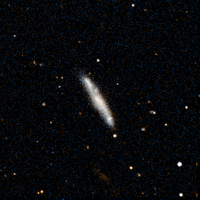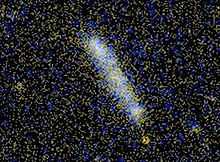NGC 7
| NGC 7 | |
|---|---|
|
NGC 7 by GALEX (ultraviolet) | |
| Observation data | |
| Constellation | Sculptor |
| Right ascension | 00h 08m 20.9s |
| Declination | −29° 54′ 54″ |
| Redshift | 0.004987[1] |
| Helio radial velocity | 1495 ± 2 km/s[1] |
| Distance |
71.4 ± 5.2 Mly (21.9 ± 1.6 Mpc)[2] |
| Type |
Spiral, possibly barred[3] edge-on?[1] |
| Apparent dimensions (V) | 2.2' x 0.5'[1] |
| Apparent magnitude (V) | 13.5[1] |
| Other designations | |
| MCG-05-01-037, ESO 409-G022, AM 0005-301, PGC 627, h 4014, GC 2[3] | |
NGC 7 is a spiral galaxy located in the Sculptor constellation. It was discovered by English astronomer John Herschel in 1834, who was using an 18.7 inch reflector telescope at the time.[3] Astronomer Steve Gottlieb described the galaxy as faint, albeit large, and edge-on from the perspective of the Milky Way; he also noted how the galaxy could only be observed clearly with the peripheral vision, not by looking directly at it.[3]
Gallery

References
- ↑ 1.0 1.1 1.2 1.3 1.4 "NASA/IPAC Extragalactic Database". Results for NGC 0007. Retrieved 2010-05-03.
- ↑ "Distance Results for NGC 0007". NASA/IPAC Extragalactic Database. Retrieved 2010-05-03.
- ↑ 3.0 3.1 3.2 3.3 "DSS Images for NGC 000 thru NGC 099". NGC/IC Project. Association of Universities for Research in Astronomy, Inc. Retrieved 25 November 2008.
External links
| Wikimedia Commons has media related to NGC 7. |
- NGC 7 on WikiSky: DSS2, SDSS, GALEX, IRAS, Hydrogen α, X-Ray, Astrophoto, Sky Map, Articles and images
| ||||||||||||||
